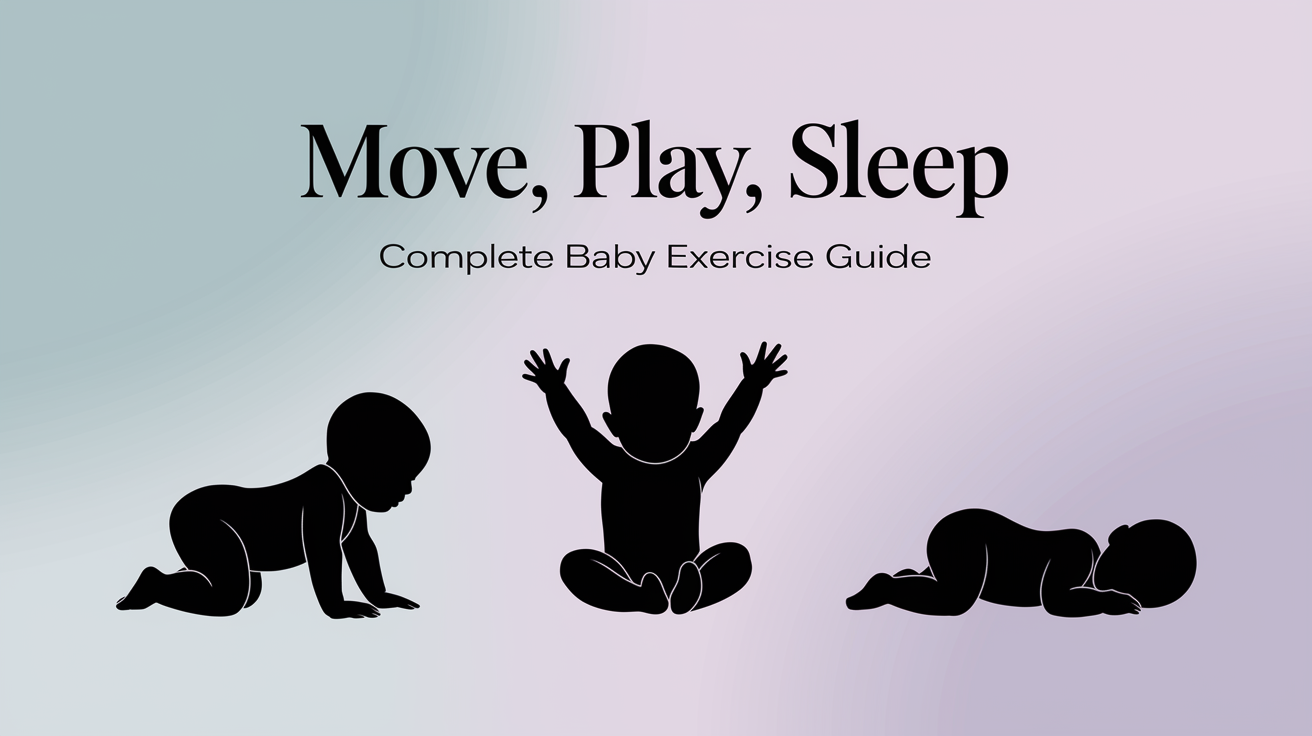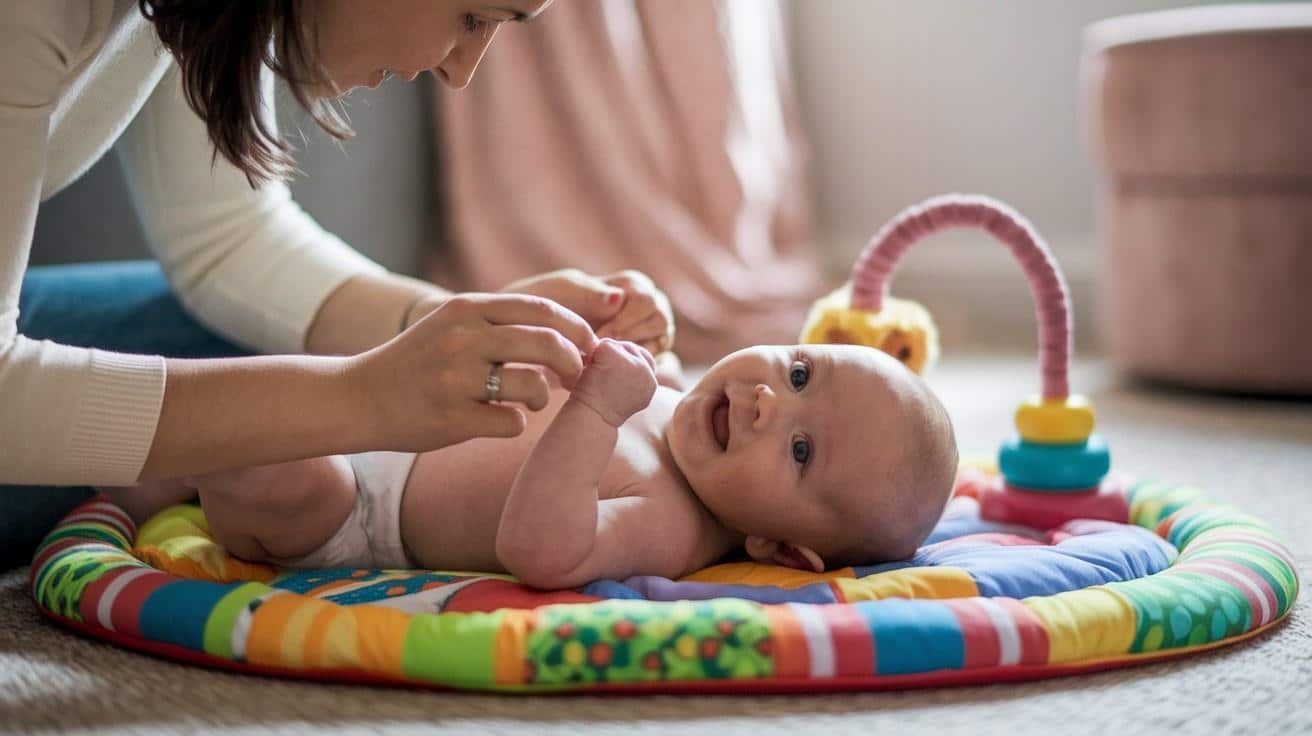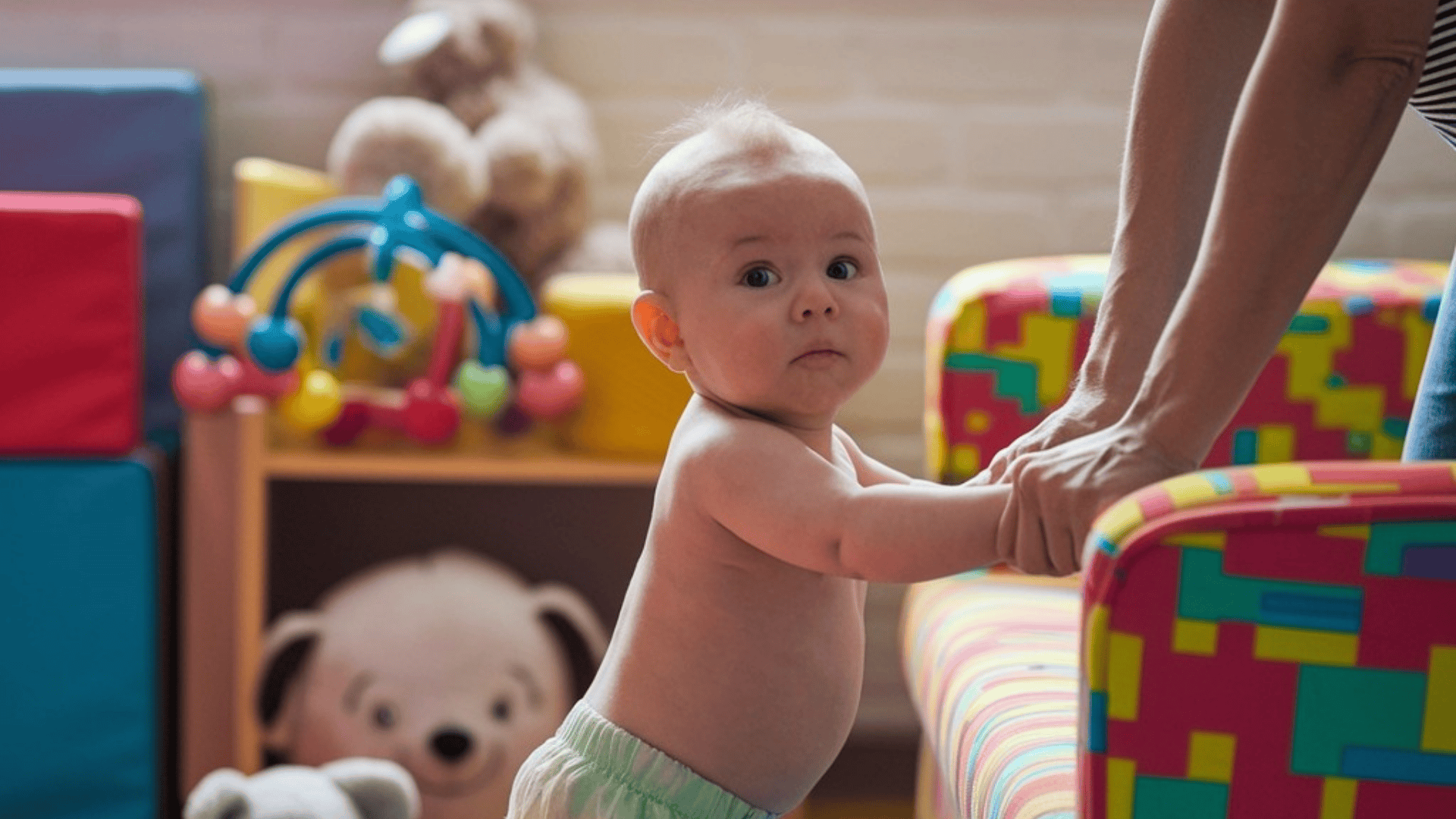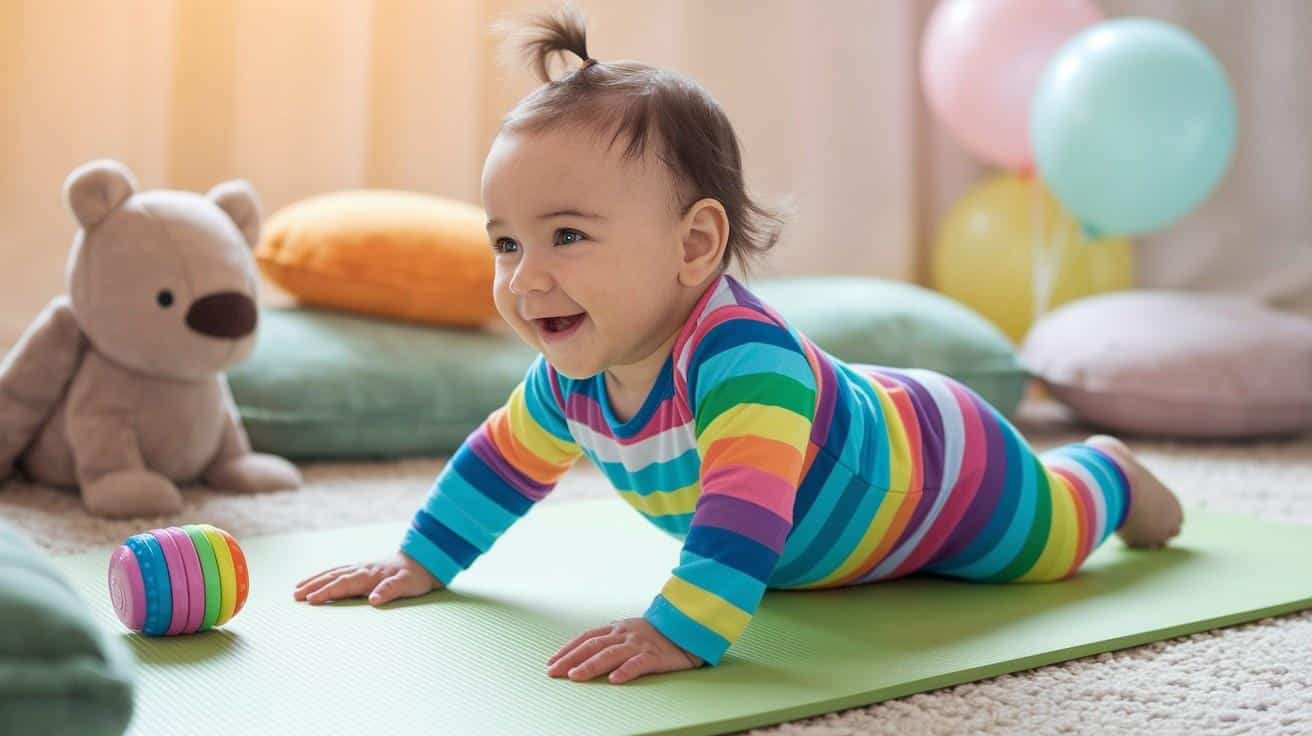
Every wiggle, kick, and arm wave your baby makes isn’t just adorable—it’s building their future.
Did you know that those seemingly random movements are actually forming crucial brain connections that help your little one understand their world?
From gentle newborn stretches to pre-toddler walking support, exercise plays a vital role in your baby’s development trip.
Physical activity doesn’t just strengthen muscles; it enhances coordination, improves sleep quality, aids digestion, and creates precious bonding moments between you and your child. Even more surprising: proper daytime activity directly impacts how well your baby sleeps at night.
If you’re guiding tummy time with a reluctant newborn or creating obstacle courses for your cruising 10-month-old, this guide will help you convert everyday moments into developmental gold.
Why Baby Exercises Matter?
Those little kicks and arm waves aren’t just cute – they’re building your baby’s muscles! Regular exercise helps babies develop strength, coordination, and flexibility right from the start.
These movements lay the groundwork for bigger milestones like rolling over, sitting up, and eventually walking.
Exercise isn’t just physical—it’s brain food! When babies move, they form connections in their brains that help them understand their world.
Each new movement teaches them about their body and what it can do. Plus, moving around lets babies study different textures, sounds, and sights.
Exercise time is bonding time! When you help your baby stretch and move, you’re building trust and communication. Your smiles, gentle touches, and encouraging words make exercise a special moment between you two.
PRO TIP: Make eye contact and talk to your baby during exercise time. Describe what you’re doing: “Now we’re stretching your legs! Doesn’t that feel good?” This builds language skills while you build muscles!
Newborn Exercises (0-3 months)

Gentle Stretches for Flexibility
Your newborn might seem light, but gentle stretches are important! Try these simple moves:
- Bicycle legs: Gently move your baby’s legs in a cycling motion
- Arm crosses: Softly bring arms across chest and then open wide
- Full-body stretches: Help baby stretch arms above head while stretching legs
Keep movements slow and gentle, watching your baby’s face for signs of enjoyment or discomfort.
Tummy Time Techniques and Progression
Tummy time is crucial for building neck and upper body strength! Start with just 1-2 minutes a few times daily, gradually increasing as your baby gets stronger. Get down on their level and make funny faces to keep them engaged.
But wait – what if your baby hates tummy time? Try these tricks:
- Roll up a small towel to place under their chest for extra support
- Lie on your back and place baby on your chest for a gentler version
- Use a tummy time mat with interesting textures and mirrors
Simple Movements to Aid Digestion
Did you know exercise can help with those baby gas bubbles? Try these soothing moves after feeding:
- Gentle tummy circles (clockwise) with your fingertips
- The “I Love U” tummy massage – trace those letters on baby’s tummy
- Knees-to-chest holds to help release trapped gas
Visual Tracking Activities
Help your baby’s vision develop by holding high-contrast toys (black, white, red) about 8-12 inches from their face and slowly moving them side to side. Watch as your baby’s eyes follow along!
Growing Baby Exercises (4-6 months)

Supporting Rolling and Core Strength
Your baby is getting stronger! Help them practice rolling by gently guiding them from back to side. Place favorite toys just out of reach to encourage reaching and rolling.
Core strength is also developing. Try assisted sit-ups: Hold the baby’s hands and gently pull them from lying to sitting position, supporting their head and neck as needed.
Assisted Sitting Exercises
Prop your baby in a sitting position with cushions around them for support. Sit facing them and play peek-a-boo or offer toys to reach for. This builds back and core muscles needed for independent sitting.
Reaching and Grasping Activities
Hang toys within reach during tummy time or when the baby is lying on their back. Offer rattles and soft toys of different textures to encourage grasping. The reaching motion builds shoulder strength while developing hand-eye coordination.
Leg Strengthening Movements
Hold your baby under the arms in a standing position, letting their feet touch your lap or a firm surface. They’ll naturally push down, strengthening leg muscles. Make it fun by singing or bouncing gently!
PRO TIP: Create an exercise routine that follows natural transition times in your day – like after diaper changes or before bath time. Consistency helps your baby know what to expect and look forward to these activities!
Mobile Baby Exercises (7-9 months)

Pre-Crawling Exercises
Is your baby rocking on hands and knees? They’re getting ready to crawl! Help them practice by:
- Placing toys just out of reach during tummy time
- Gently supporting their feet as they push off with their legs
- Creating a “tunnel” with your legs for them to crawl through
Balance Development Activities
Sit your baby on your lap, facing outward. Gently tilt them side to side, forward and back, while supporting their trunk. This helps them develop balance responses. Make sure to make silly sounds as you tilt for extra giggles!
Hand-Eye Coordination Games
Roll a soft ball toward your baby and encourage them to push it back. Stacking cups or blocks (with your help) also builds hand-eye coordination and fine motor skills.
Pre-Toddler Exercises (10-12 months)

Cruising and Walking Support Activities
Your baby may be pulling up to stand and “cruising” along furniture! Support this development by:
- Place favorite toys on the couch to encourage pulling up
- They hold their hands while they practice stepping
- Creating an obstacle course of cushions to cruise around
Fine Motor Skill Challenges
Fill a container with large blocks or toys and show your baby how to take them out and put them back. This seemingly simple activity builds important hand coordination and understanding of spatial relationships.
Independent Movement Encouragement
Let your baby practice moving independently in safe spaces. Clear a baby-proofed area and let them explore. Resist the urge to always put them in the exact position you want – let them work to get there!
Multi-Sensory Exercise Games
Combine movement with sensory exploration. Try water play with kicks and splashes during bath time, or dancing while holding your baby to different music tempos.
Making Exercise Fun and Consistent

Incorporating Music and Rhythm
Babies love music! Play different types of music during exercise time. Try slow songs for stretching and upbeat tunes for bouncing and dancing. Sing simple songs with movements like “Head, Shoulders, Knees and Toes” even with the tiniest babies.
Using Household Items as Exercise Props
No need for fancy equipment! Use these everyday items:
- Scarves for gentle tug-of-war or peek-a-boo
- Couch cushions for crawling obstacles
- Empty paper towel rolls as reaching targets
Safety Guidelines for Baby Exercises

Recognizing Your Baby’s Exercise Limits
Watch for these signs that your baby needs a break:
- Turning head away
- Fussing or crying
- Arching back
- Becoming red-faced
Always support your baby’s head and neck during exercises until they have full control. Use firm but gentle touches, and move limbs in natural directions – never force a movement that meets resistance.
When to Consult with Professionals?
Talk to your pediatrician if:
- Your baby strongly dislikes certain movements
- You notice asymmetry (preferring one side)
- Your baby isn’t reaching movement milestones
- You’re unsure about exercises for your baby’s specific needs
PRO TIP: Take photos or videos of your baby during exercise time every few weeks. This creates precious memories and helps you see their amazing progress over time!
Exercise and Baby’s Sleep Connection

How Activity Levels Affect Sleep Quality
Have you noticed your baby sleeps better after active play? Appropriate exercise helps babies release energy and regulate their nervous systems. But timing matters – active play right before naps or bedtime might be too stimulating.
Creating a Balance Between Rest and Activity
Watch your baby’s signals. Are they alert and engaged? It’s a great time for exercise! Are they rubbing their eyes or getting fussy? It’s time for rest. A good rhythm of activity and rest throughout the day helps establish healthy sleep patterns.
What If My Baby Doesn’t Enjoy Exercise?
Some babies are more sensitive to movement than others. Try:
- Shorter, more frequent sessions
- Different times of day (not when hungry or tired)
- More playful approach with songs and games
- Different positions – maybe they prefer sitting support to tummy time
Adapting for Premature Babies
Premature babies might need adapted exercises. Always consult your healthcare provider, but generally:
- Start more gradually with shorter sessions
- Provide extra support and gentler movements
- Focus on corrected age, not birth age, when considering milestones
Exercises for Babies with Special Needs
Babies with special needs benefit greatly from adapted exercises. Work with your healthcare team to create a custom plan. Early intervention specialists can show you specific movements to support your baby’s unique development.
Remember, exercise shouldn’t feel like work to your baby. The best movement happens through play, connection, and joy. By moving a regular, fun part of your day together, you’re giving your little one the physical foundation they need for a lifetime of healthy development!
The Last Note
From those first bicycle leg movements to the exciting pre-walking stages, exercise is fundamental to your baby’s physical, cognitive, and emotional development.
We’ve researched age-appropriate activities from newborn to pre-toddler stages, showing how simple movements build the foundation for major milestones like rolling, crawling, and eventually walking.
Remember that baby exercise isn’t about achievement but about joyful exploration—following your little one’s cues, providing gentle support, and celebrating each new movement.
The right balance of activity and rest creates healthy sleep patterns, while everyday household items can become perfect exercise props.
By incorporating these exercises into your daily routine through playful interaction, you’re strengthening your baby’s muscles, strengthening your bond, and setting the stage for a lifetime of healthy development and movement.
If you’re interested in more informational content on mothers and babies, feel free to click here and research other blogs that you might enjoy.
